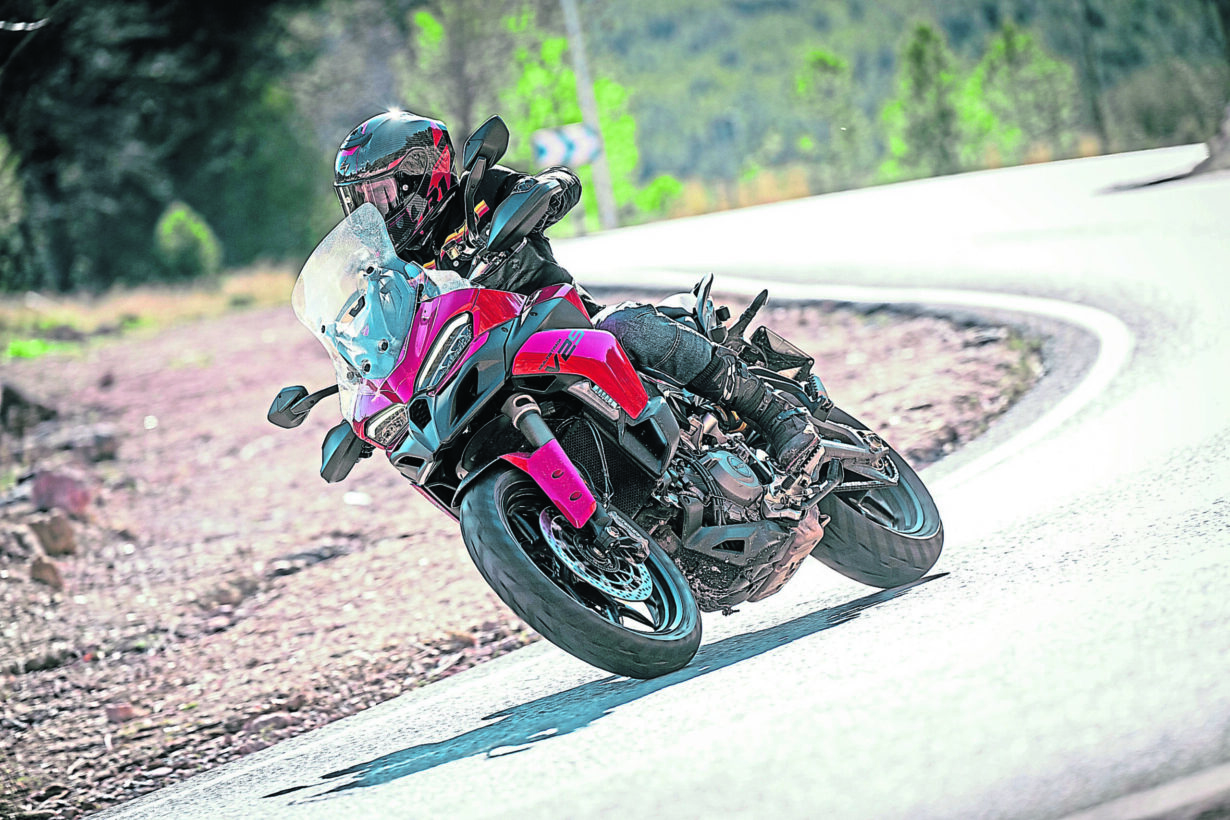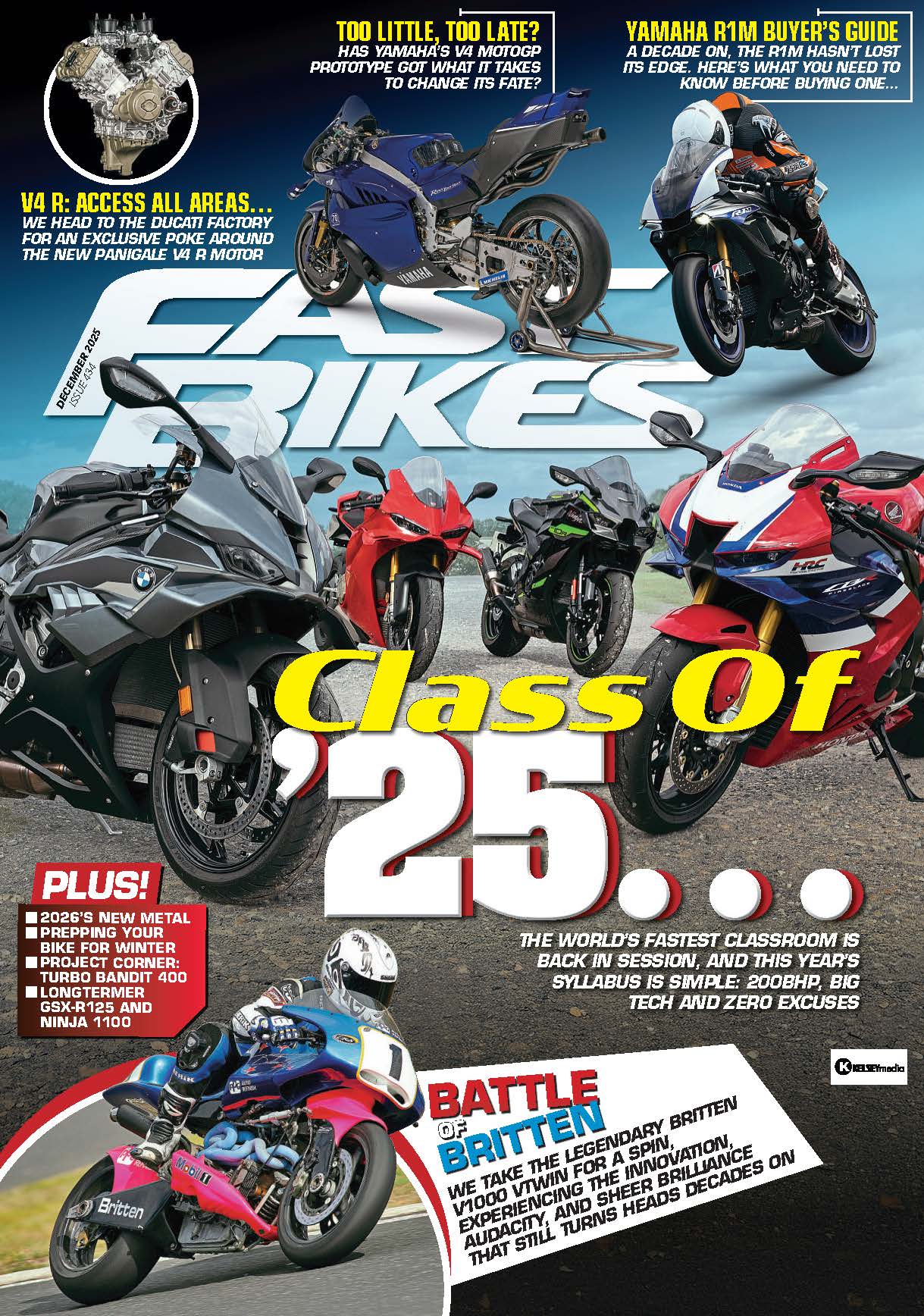While the name’s the same as its predecessor, pretty much everything else about the Multistrada V2 is box fresh… and that’s not a bad thing. The Multi’s style and family attributes may have remained, but for the 2025 model year the twin cylinder Multistrada has had a comprehensive redesign, so while still remaining cosmetically as the popular adventure bike, with a few sharper lines on the design, under the skin all is new. Dave Manning tells us what we need to know…
The heart of the refreshed and reinvigorated Multi’ twin is the new 890cc engine which is, in something of a quirky fashion, a smaller capacity than the previous iteration. Invariably, a new version of a bike gets a larger, more powerful engine, but times are a-changin’, and the smaller lump in the Ducati aligns it with various other models that are assigned the new engine, namely the Streetfighter V2 and Panigale V2.
The new engine is, according to the briefing, the lightest Ducati has ever built (weighing in at a mere 54.9kg), although I’m a little doubtful of that claim with the memory of the air-cooled 400cc engine fitted into a 400SS (and Monster as well, I think) used for the Japanese market. But my overflowing memory banks are also thinking the 400 was a sleeved-down 600cc engine, so maybe I’m wrong? However, we can definitely say the new powerplant is the firm’s lightest water-cooled vee twin so far… It’s not just light, but commendably narrow, too, helping to give the bike a slim waist, and the reduced dimensions – not just of the actual engine itself, aided by cylinder liners that are cast as part of the crankcases, but of the combined engine/fuelling/cooling package – have allowed the bike to be subtly but noticeably reduced in size. It’s not massively different, but just enough to make it noticeable when you throw a leg over the seat. It feels more manageable, and less cumbersome. More centralised in terms of volume and mass, yet still roomy enough for long days in the saddle.

Ergonomically, it’s close to ideal for my 5′ 11″ frame, although the bars were a touch lower than expected and look as though they’ve been turned backwards and down. It’s not a negative point, just a little quirky, and while these bikes will probably be unlikely to be used off-road and thus not need bars that give good ergonomics when standing on the pegs, it still has the ‘flip-over’ brake lever tip for use when riding standing up.
Handlebars aside, quirkiness is otherwise something that’s been bred out of Ducati vee twins of late, and this new V2 engine epitomises that statement. It wasn’t very long ago that the vee twin powerplants from Bologna were a bit grumpy low down in the rev range. They’d deliver a punch, but if you were in too high a gear, or making the engine labour, it’d complain, with a shaking and a thudding that cried out for a down-change. The design of the new powerplant, despite being of a smaller capacity and remaining as a traditional 90° ‘L’ twin, has focussed on giving better low-down driveability, with the inlet cam now having variable valve timing to help achieve this – although there’s an underthought that suggests the application of variable valve timing is to help emissions and thus pass Euro 5+.
So, in direct contrast to the glut of parallel twin engines that have had rephased cranks to attain a more vee twin style delivery, the development of the Ducati engine has gone the other way, and it’s become more like a parallel twin. This convergence has resulted in a bike that feels and sounds much like parallel twin competitors, and while that sounds like it’s a bad thing, that would be unfair, as the engine is great – really tractable, punchy, yet with a spirited top end that will please those folk who like to chase the redline. The designers’ brief was to focus on low rev smoothness and provide a flat (er) torque curve. With a max of 69.7lb-ft (which is decent enough for a twin of this capacity), it delivers 70 per cent of that at 3000rpm.
While it is the same 890cc engine as fitted to the new Panigale and Streetfighter vee twins – which, incidentally, hasn’t been given a name like previous engines, but is simply referred to as ‘V2’ – it has a shorter first gear, and a taller sixth (higher luggage/pillion capacity and improved fuel consumption while touring being both the aim and the result), while the crank’s flywheel is heavier than in the sportier variants, bringing a 20 per cent increase in inertia to give a smoother power delivery and reduce any snatchiness at low rpm. Oh, and with long service intervals (9000 miles or two years for an oil change, 18,000 miles for valve clearance checks), it’s clear the factory has set this as being a long-lived powerplant, backed up by the unlimited mileage, 48-month warranty.

The reduced bulk of the engine has the side effect of the combined engine/frame/rear subframe package being more compact, although it is a shame the beautiful trellis subframe (despite being painted bright red) is hidden from view by the plastics of the tail unit, although to call it a ‘rear subframe’ is perhaps a bit misleading as it extends forward right to the top of the rear cylinder head. The frame itself is no longer a steel trellis unit, but an aluminium monocoque of a similar style to that embellishing the V4, using the engine as a stressed member. The trimming of weight off so many components brings the 2025 V2S to 202kg, a full 18kg lighter than the outgoing 2024 model, although it’s also worth noting the basic V2 model, without the S version’s Skyhook suspension, etc., is 199kg.
Given that the models we rode were the S version, with the spanglepants Skyhook suspension, it has the neat ‘Minimum preload’ function activated by holding the Skyhook button (operated by your right-hand index finger), which reduces ride height by 8mm. It might not sound much, but it does make the difference between tippy-toes and feet flat on the floor.
The suspension modes are Dynamic, Comfort, Low Grip and Off-Road, and while the V2S is aimed at road riding, with very light off-road capability, it is worth noting that Ducati offers spoked wheels (in the same 19-inch front, 17-inch rear sizes) as an accessory for those who might want to indulge in muddier pastimes, at just over £1300. Other accessories include a Tyre Pressure Monitoring system, satnav, engine bars, heated grips, etc. Yes, the grips are an accessory.
Despite the launch being in Spain, the hills north of Valencia were surprisingly fresh, and heated grips would’ve been almost as welcome as they would be back home (as it happens, my ride home from Gatwick was at the same temperatures as the morning of the launch ride, albeit I had winter gloves, thermals and heated seat and grips on the Voge, rather than summer gloves, riding jeans and jacket and no electrically-derived warmth on the Duke…). In a similar vein, the fairing lowers are designed to deliver cooling air from the front of the bike to the rider’s lower legs. Oh, and if you want to warm your pinkies while you’re sat at a set of lights, it’s a real stretch to get to the only accessible parts of the engine (that being the crankcase covers).
The 5-inch TFT screen offers three dash layouts – Road, Road Pro and Rally – which display a number of different variables, and while the Rally version is perhaps the most aesthetically-pleasing arrangement, it probably has too much info on display and makes it hard to read at a glance. But, given the number of options (as a clue, the press pack contained an astounding 48 images of the dash, in a bid to show the variety) you can set up the dash exactly how you choose to your preferences.
The adjustable screen is a doddle to operate, and pretty efficient, too – not too noisy below 60mph-ish, and little in the way of buffeting in either low or high position, while in the high position it has the effect of forcing rain on your visor in a downwards direction which, in my experience, suggests that it’ll be good in truly horrid rain. And, yes, we did have some rain on the Spanish launch event.
The reduction in width of the combined engine/frame means the minor niggle I had with the old bike, that of my right heel being pushed outwards, has disappeared, although I did get to feel the swingarm moving around with my left heel – but, of course, both of these could be indicative of how I position my feet while riding, and may not be an issue for anyone else.

Aside from the suspension options and the screen options there are, of course, various riding mode options, too. Five in fact. Wet mode is more spritely than that on other bikes, and it seems that rather than just program in a tardy throttle response that requires greater action from the right hand, Ducati has spent some time ensuring there’s a feeling of direct connectivity between right hand and throttle bodies, while still softening the delivery of power.
The irony of that is that even in dire weather conditions, you’ll perhaps not actually need the Rain mode, and can stay in the super-flexible Touring, thanks to the encouraging level of feedback and feel. Sport is a bit feistier, mind. The remaining two, Urban and Enduro, didn’t get tried on our ride around the hills north-west of Valencia.
Staying in the realm of smoothness, aside from the throttle action, the way that power is delivered at low rpm is really rather impressive for a vee twin of this capacity. Okay, it’s not a honking great twin of American standards, but it’s not that far short of a litre, and you’d not expect it to happily bimble around in town and village and smoothly pull away from 1500rpm in third gear. Impressively, in a better fashion than some parallel twins. If you’re a fan of traditional vee twins (and especially old school air-cooled Ducati ‘L’ twins) you may not like it, but it is infinitely better in town and traffic.
A further bonus is the ‘anti-stall’ function when letting out the clutch lever, raising rpm from the usual tick-over of about 1100rpm right up to 2000rpm, meaning that it’s perfectly feasible to ride around at (very) slow speed without even touching the throttle! Out of town, it spins up to 10,000rpm with some verve, and a not-unpleasant soundtrack, with the occasional ‘pop’ on the upshift courtesy of the quickshifter, which is now mounted to the gear selector drum rather than the shifter linkage. This should not only improve the action of the shifter (which only showed little niggles when used at what were, to be fair, inappropriate times), but also aid in longevity of the gearbox. The rear brake wasn’t quite as effective as I’d expected, but then I do use the rear a lot in town and traffic, and for most folk this would probably not be something they’d even think about.
When you’re done for the day, there’s the ‘coming home functionality’ which holds the headlight on for a further 30 seconds after you’ve switched the ignition off, so you can see the way from the bike to your front door. What’s not to like?

Specification:
Ducati Multistrada V2S
Engine: 890cc, V-twin, water-cooling, 4 valves per cylinder, variable inlet valve timing, 96×61.5mm bore/stroke Power: 113bhp (85kW) @ 10,750rpm Torque: 67.9lb-ft (92.1Nm) @ 8250rpm Frame: Aluminium monocoque, steel trellis subframe Wheelbase: 1573mm Rider aids: Adjustable cornering ABS, 5 rider modes, 4 suspension modes, 3 dash displays, quickshifter, wheelie control, traction control, engine brake control Brakes: (F) 320mm discs, 4 piston radial Brembo calipers, (R) 245mm disc, 2 piston Brembo caliper Transmission: 6 gears, chain final drive Suspension: Skyhook electronic control, (F) Marzocchi 45mm forks, semi-active, fully adjustable, 170mm travel. (R) Marzocchi shock, semi-active, fully adjustable, 170mm travel Wheels/Tyres: Cast aluminium wheels. (F)120/70×19″. (R) 170/60×17″, Pirelli Scorpion Trail II tyres Seat height: 830mm Fuel capacity:19 litres MPG: 47mpg Weight: 217kg (wet) Warranty: 48 months unlimited mileage Service intervals: 9000 miles/24 months oil change, 18,000 miles valve check
Price: £16,390 (base model £13,995) Contact: www.ducati.com
Other things to know…
Frame – Reduced in size and mass, the all-new frame is, in reality, a pair of subframes mounted to front and rear of the engine. Engine – The all-new V2 engine, with a reduced capacity of 890cc and variable valve timing on the inlet side, has only minimal changes between the Multistrada, the new Panigale, and the new V2 Streetfighter. Suspension – The S version has the Skyhook suspension, electronically adjusted to suit any of the four modes, with the neat preload reduction button bringing a ride height reduction of 8mm for a firm footing. Electronics – Lots of variety here, from the Skyhook suspension to the five rider modes and multitudinous variety of TFT dash displays. The rider modes are themselves individually adjustable, with traction control, torque control, peak power, throttle response, anti-wheelie, engine braking and ABS all available to alter. Luggage – We didn’t get to ride with the luggage package on the S models that we had, but they come with the Touring pack that also includes heated grips and a centrestand, priced at £1116.




